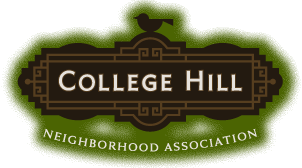Listing of State Listed Historical Properties in College Hill
304 S CIRCLE DR, 303 CIRCLE DR, 400 S ROOSEVELT ST, 330 N CRESTWAY AVE, 263 S PERSHING AVE, 4230 E ENGLISH, 3750 E DOUGLAS AVE, 201 N BROADVIEW AVE, 140 N HYDRAULIC AVE, 205 N PERSHING AVE, 225 N ROOSEVELT AVE, 255 N ROOSEVELT AVE, 136 N CRESTWAY AVE, Old White Farmhouse Mansion 3401 E. 2nd St. N., 320 N BELMONT AVE, 158 N ROOSEVELT, 235 N ROOSEVELT ST
History...
The College Hill residential area comprises approximately one square mile bounded by Hillside Avenue on the west, Central Avenue on the north, Oliver Avenue on the east, and the Kellogg Expressway on the south. The neighborhood is located approximately 2.5 miles east of the Arkansas River and the commercial core of Wichita. The land was originally part of the buffalo hunting grounds of the Osage Indian Reservation, opened by the government to settlement in 1870, the year of Wichita's incorporation as a city. For its first "settled" decade the area was dotted with family farms featuring wheat and corn fields, orchards and vineyards, hedge rows and gardens.
The original landowners, such as George O. Merriman and M.R. Moser, soon envisioned the land being more desirable for suburban living than farming and platted their holdings into real estate additions. Merriman platted the Merriman Park Addition where College Hill Park is located today. Moser platted the College Hill Addition where a college was planned to be built in the center of "College Park" on Douglas Avenue (uphill from Rutan to today's Clifton Square). These visions were inspired by Wichita's real estate boom days of the mid-1880s.
During the boom improvements to the area were made by planting trees, grading the streets, and running a mule-drawn street car line to the hill. To the south Wichita University was built at the end of Lincoln Avenue. To the north Fairmount College was built at 17th and Fairmount. The two institutions shared the same scenic ridge and had a panoramic view of the Arkansas River Valley. However, a real estate bust occurred in 1887 before "Central University" could be built, centered between the two earlier colleges. Wichita University closed in 1893, its building succumbing to fire in 1913. Today its land is owned by the Sisters of St. Joseph. Only Fairmount College remains, incorporated in today's Wichita State University.
The square mile encompassing the College Hill neighborhood consists of gradually upward sloping, gently undulating terrain in the western portion, and a relatively level hill crest in the eastern part. At its highest point the "hill" rises approximately 75 feet above the downtown business district. Although the city's early flooding problems were eventually resolved by channel projects, College Hill's location above the area floodplain was seen as a desirable homeownership attribute. As a result many of the city's finest homes of the early twentieth century were built in College Hill. The last unfilled 80 acres was developed by realtor Walter Morris, platting his southeastern tract in 1927 as the Lincoln Heights Addition and filling it with unique and stylish homes. Additionally in 1949 he provided the neighborhood with its anchor asset to the east the Lincoln Heights Village Shopping Center. - Information courtesy of Jeff Roth, May 2010


